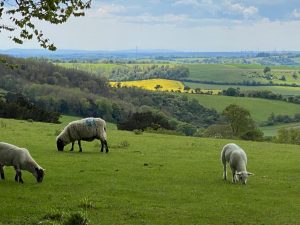Monarch’s Way ride – Thursday update from Mr Roche
Yesterday we started cycling from Winchester heading east. You will remember that we arrived at Winchester (once the ancient capital city of England), from Salisbury following the path taken by King Charles II on the trek that he made on his way to France. He wanted to escape pursuit and capture by the armies of Oliver Cromwell, the man who had taken away his role as the King of England.
We know that Charles eventually finished his journey in Shoreham, a town close to where we all live. The best route from Winchester to Shoreham is via the South Downs Way, an ancient track that follows the tops of the South Downs and would have been ideal for Charles’ purpose. So why did he not go this way? Well, at this time Charles did not actually know that he wanted to go from Shoreham. All he wanted to do was to leave from somewhere …… anywhere …. along the south coast to get away from Cromwells army who knew of his whereabouts and were slowly closing in on him.
From his secret hideout in Winchester he would first have sent parties of loyal followers due south to check if he could get on a ship from Southampton or Portsmouth. In those days there were no car ferries as we have today day, just a basic Navy fleet who were already committed to serving Oliver Cromwell. So he had no luck there. But maybe there might be a chance of securing a boat at one of the smaller ports: perhaps Emsworth or Chichester? But again no luck there either as it was soon found that these towns too were under the control of Cromwell’s men!
And so Charles’ route (and ours yesterday), went south and then east from Winchester. He crossed the beautiful Hampshire countryside as it undulates – which means it rises and falls in height usually quite gently but there are still some steep hills – please see the photo below. The great thing about this sort of open countryside is that once you have reached the top of a hill you can coast gently downhill for miles and miles without pedalling. There’s a great expression that says that “travel brings adventure” and this sort of riding is certainly that, it is like being on a great big long roller-coaster fare ground ride that lasts for ages and ages.
Similarly, when you travel long distances you often accidentally find things that you didn’t expect to see. For example – and this is nothing to do with Charles II – as we cycled close to a village called Hambledon we happened to find a memorial stone, located on a village cricket green opposite a pub called “The Bat and Ball’. But this is not any old cricket green or any old pub: rather, it is the very place where the modern day game of cricket was devised,100 years or so after Charles passed here.
The view in the photo below shows the outlook from the highest point on our ride of yesterday. This place is called Old Winchester Hill which itself is a bit odd because whilst it certainly is a hill and it is very old, it is a long way from Winchester. From up here Charles, like us, would have been able to see clearly right across to the English Channel. The hills that you can just see in the far distance are actually the Downs on The Isle of Wight. This view is very similar fo that which Charles would have seen in his time, indeed it is known that Stone and Iron Age people lived up here because this place has a hill fort almost almost identical to our own Cissbury Ring near Findon. The Roman’s would also have stationed themselves up here to keep watch out to sea in case their enemies approached!
From these forts people could send messages using beacons (made of small fires) to flash news to the next fort and from there on to London or down to the coast. It certainly would have been possible for someone standing on this hill to send and receive coded messages with someone on Cissbury Ring. Perhaps Charles’ party managed to receive messages from Findon to tell them that they could safely proceed there, as we intend to do today.
What King Charles would not have seen are the tall chimneys seen distantly on the right of our picture as these are part of a modern day oil refinery near Southampton; similarly he would not see the tall pillar in the middle distance as this is the recently completed Spinnaker Tower in Portsmouth.
We are now staying in a village called Rowlands Castle and from here we plan to ride to Findon arriving at your school tomorrow morning. We hope to see you then.
